Alexander Grant Mackie 1854-1933
and
Margaret Munro Montefiore 1867 - 1963
Alexander Grant Mackie was born, a son of the Manse of Alves, Morayshire on 8 June 1854.
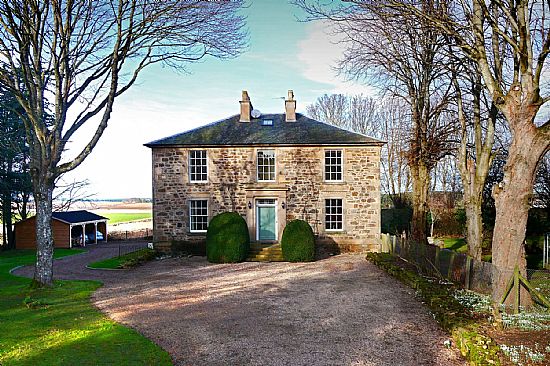
A photo of the Manse taken by Finlay Grant for Galbraith Estate Agents in Elgin shows how it has been beautifully restored.
Beyond the house on the far horizon it is just possible to make out the dark blue line of the Moray Firth. There is not much shelter from the north easterly winds by the look of things which is why the house appears to be facing away from the firth and looking towards the southwest. This is "the sunshine coast" of Scotland, however, and it is also one of Scotland's most fertile farming areas.
Alexander's father, the Reverend James Mackie, was a farmer’s son from Rothiemay. Alexander, himself, got his first name in traditional fashion from his grandfather.
The Rothiemay farm was sufficiently productive of disposable income for James to be able to attend Marischal College at Aberdeen University.
After a spell as a schoolmaster in Keith he was licensed by the presbytery of Elgin in 1846. By 1852 he had been ordained and presented to the parish of Alves by the church's patron Francis, Earl of Moray.
The Alves minister’s income was not large but was supplemented by some teaching in the school and by the produce of the glebe, a small croft near the Manse.
Such a situation made marriage not just a possibility but a necessity.
It was in the Spring of 1852 that the Reverend James Mackie and Eliza Ferrier Nichol set out on married life after their wedding in Inverness.
Eliza was the daughter of a distinguished Inverness doctor, John Inglis Nicol MD , whose Medical studies had taken him as far as Tubingen in Germany. His portrait hangs in the Town House of Inverness.
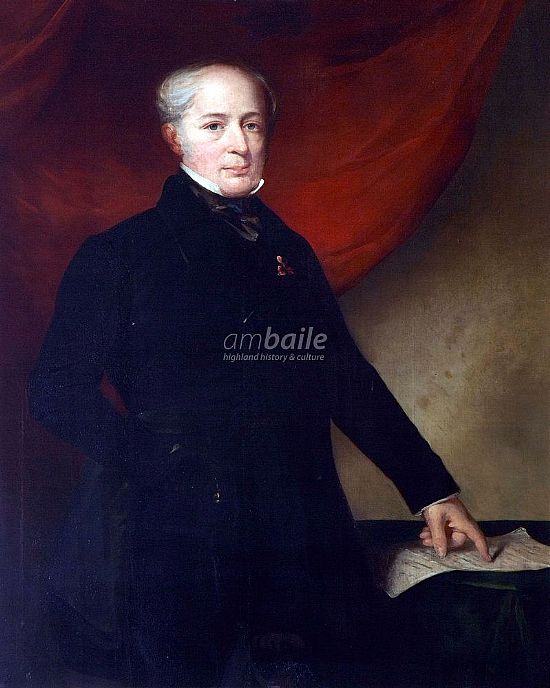
Portrait of John Inglis Nicol painted by Robert Innes which hangs in Inverness Town House: Highland Council via the Am Baille website
Inglis worked tirelessly on the Council as well as in his practice to improve the town’s environment and health. He died of cholera whilst attending patients during an outbreak in the city in 1849.
When Alexander Grant Mackie was born at Alves Manse in 1854 he could count on a fine heritage, if not a wealthy one, from both his parents. He could live in the comfort of well-earned social esteem as well as the relative security of a manse in the Established Church of Scotland.
It probably seemed quite natural that he should aim for University even though the family had grown considerably by the time he was making his career choice.
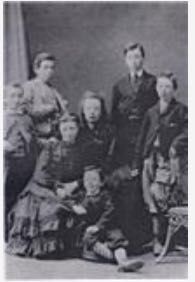
Family Photo of the Mackie children. The smartly be-suited Alexander is standing at the back second from the right. [ hopefully a better quality image can be obtained ]
Alexander studied engineering at Edinburgh University [still waiting for corroboration from the University.]
After graduation he took ship for Ceylon where coffee growing was booming. He arrived in 1875. Sadly for him, this was exactly the same year that the coffee rust virus spread to Ceylon.
Redundant in the coffee plantations, he, like quite a number of ex-coffee planters did not wait to join the Taylor/Lipton experiments that would make Ceylon synonymous with fine tea for generations to come.
Instead he took a boat to Malaya where his engineering skills could be employed profitably.
He landed in the port of Selangor in 1883. The demand for tin, particularly in the new food-canning industry, began to offer rich rewards for mining the ore. The increase in mining also required a better infrastructure across the country so there was plenty of work for an enterprising engineer.
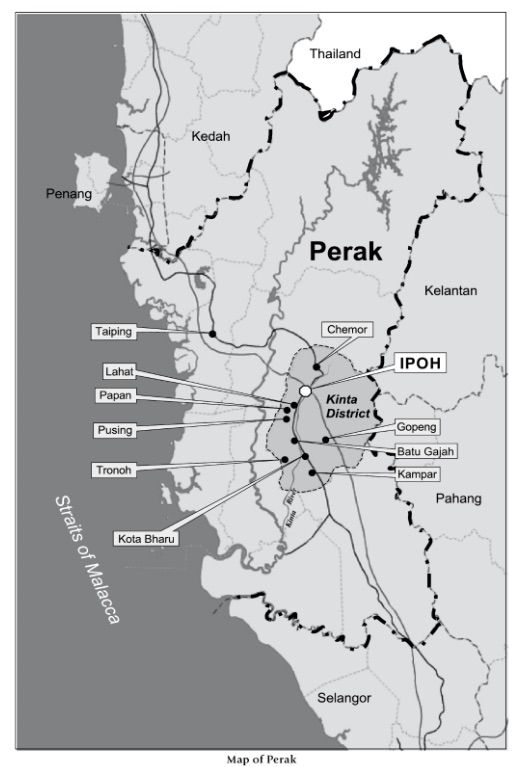
Map of Perak from Ipoh : When Tin was King by Ho Tak Ming, Perak Academy
Malaya already had a long history of tin mining but at this time it was very labour intensive and supplies could not, therefore, keep pace with the growing demand.

Mackie headed for Perak the following year where the firm of contractors, Hill and Rathbone, offered him a job. He was later to become a partner in the firm which worked on the road and rail contracts.
He also made good use of his experience in Ceylon to open up the Kamuning Estate, Sungei Siput in 1887 for Thomas Heslop Hill who had been rewarded with rent-free land by the government for his work on the country’s infrastructure.
Mackie ensured diversification on the estate rather than monoculture which had been a problem in Ceylon. Coffee bushes were complemented by papaya, lemon grass and pepper. Papaya juice soon became a valuable export.
At the same time he was the construction engineer for the Seremban-Port Dickson railway.
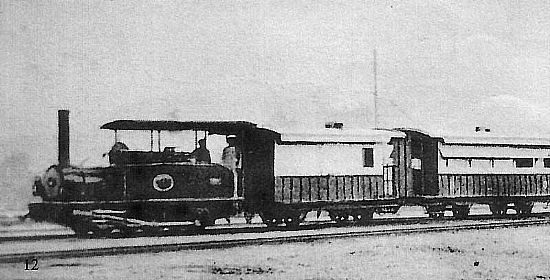
An early train and track in Perak
Multi-tasking must have required much organisation and self-discipline.
At this point he decided to move also into the boom and bust world of tin mining. His fortunes were mixed there too.
Malaysia lies on the great peninsular and island-hopping "land bridge” between Northern Asia and Australasia. It is also a natural entrepot for trans-oceanic trade east-west. As a result it has been much fought over but has also become a remarkably cosmopolitan society.

Portrait of the 10th Dato
Dato Mohamed Yusuff, in particular, welcomed Chinese, Sumatran, Indian and other immigrants in 1884 offering them building lots in Ipoh on the Kinta river for 25 dollars per lot in order to develop tin mining in the region. The Chinese worked in the mines largely, the Indians in money lending and commerce and the Sumatrans became agriculturalists.
The British Resident, Frank Sweetenham, soon asked Mackie to prospect for a road from Kuala Kangsar to Kinta, which was developing into the tin-mining centre.
Mackie set out in style, according to Dr Ho in an article in The Ipoh Echo in May 16-31, 2008 “with a party of thirty men and three elephants, hacking his way through dense jungle, taking three days for the journey”.
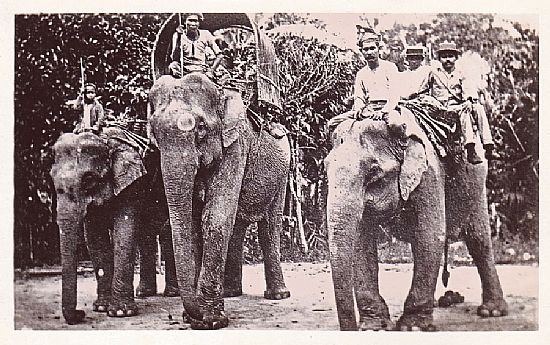
A picture postcard of three elephants with mahoots from an article by Alan Tej Leam Seng published November 11th 2019, in The New Straits Times. It is not from the expediton itself.
The dense Malayan jungle was to be recalled with intense fear and pain by some World War II soldiers but, for Mackie, it offered a challenging adventure in good company.
What they found at the end of the trek were a few attap huts on the banks of the Kinta River.
“ In Ipoh”, Dr Ho continues, "he built a bamboo hut for himself (near the present Post Office), clearing a path through the jungle to the river to bathe.”
Some of the very simple huts in the area have been rebuilt as luxurious holiday accommodation whilst the old tin-mining areas have been wonderfully transformed into tourist attractions as the mines have been allowed to infill with water to form lakes.
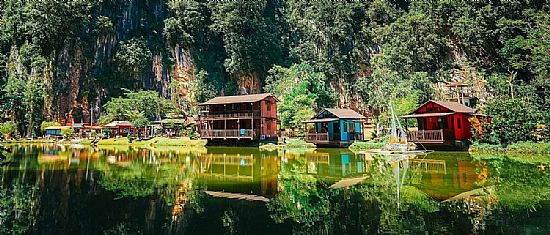
One of the characteristics that comes through clearly, in all the documents which remain as evidence of his life, is Mackie’s capacity for friendship and his appreciation of others across cultural boundaries. He seems, also, to have had the great gift of being able to “laugh uproariously” at his own mistakes. It must surely have been he, himself, who told his friends the story of his first attempt to build a tin dredger that was later published in The Malay Times.
It was described in 1911 as “a floating platform from which jets of water spouted upwards quite as lustily as do the feathery sprays from the fountains in the gardens of the Crystal Palace. The proud possessor and engineer of the ‘Lombong Hantu’ [ Mine Spirit] as some called it, is still among us in the person of Mr A. Grant Mackie. He is a Scotchman.”
This definition of Mackie's nationality allows the writer to poke gentle fun at what he sees as Scottish pioneering pretentions.
“It is not known if the first white man in Perak was a Scotchman: but researches in this direction would lead to a period bordering on the prehistoric when we were only in embyronic existence and which was considerably more than twenty years ago” .
The writer then describes how the dredger was received when Mackie tried to sell it as a commercial proposition to The Straits Trading Company. Only Mackie himself could have told this story against himself.
His machine was presented to be tested and priced.
“The test having been duly applied, the result of the assay was - well, not too gently communicated, in a strong German accent,
‘Dat was not tin ore, dis iss amang [sludge?], Ach!’
“What” exploded the irate Scot.
“So” was the quiet rejoinder.
The rest is not on record, but the dredger with its beautiful fountains and admiring crowds is no more”.
Dr Ho’s researches indicate that the dredger was not a success because Mackie had not taken into account the many trees that had fallen into the river over time and which complicated the efficiency of his prototype dredging machine. He considers that Mackie was simply ahead of his time. Soon monster dredgers would be replacing the vast army of tin miners and their sluicing methods.
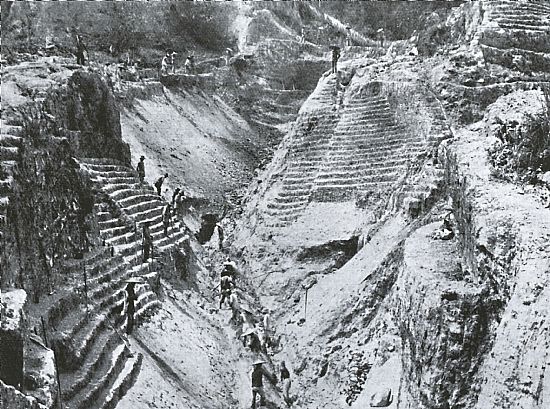
Hand extraction of the ore using gravity sluicing methods
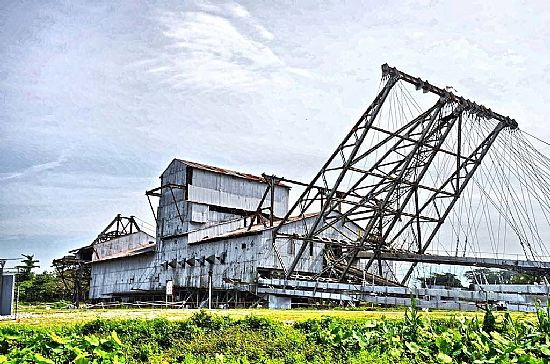
One of the last monster tin dredgers
Self-effacing about his hit and miss achievements, Mackie was definitely integrating into his chosen new homeland with dogged and generous perseverance.
To what extent he was still in touch with Morayshire we cannot know at present.
Nor do we know how he met his wife whom he married in the Anglican Church in Taiping, Perak on the 15th November 1894
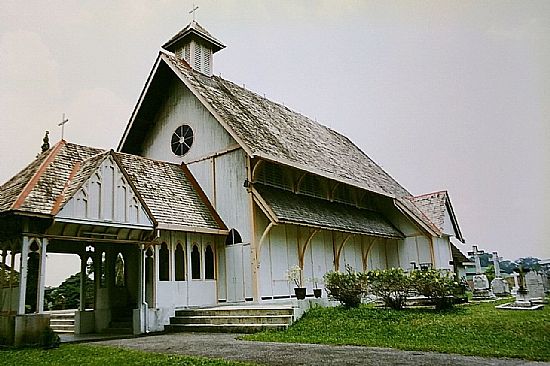
All Saints Church Taiping founded 1886: Wiki Commons: Photographer: Howcheng
Margaret Munro Montefiore, who thus added yet another M to her initials, had a rich heritage. Her paternal ancestors were Sephardi Jews who were powerful in both banking and commerce. Eliezar Montefiore, Margaret’s grandfather, emigrated from Portugal to the West Indies where he first “married” a freed slave born in 1794 with whom he had a son whom he called John Castello Montefiore.
Eliezar was then persuaded by his family to renounce his first relationship and to marry a Jewess.
Whether he was brought up by his mother or his stepmother, John Castello certainly made a name for himself in Bridgetown, Barbados as a respected merchant. He was acknowledged as “a Jewish freed coloured” .
An elaborate drinking fountain was gifted to the town in his memory.
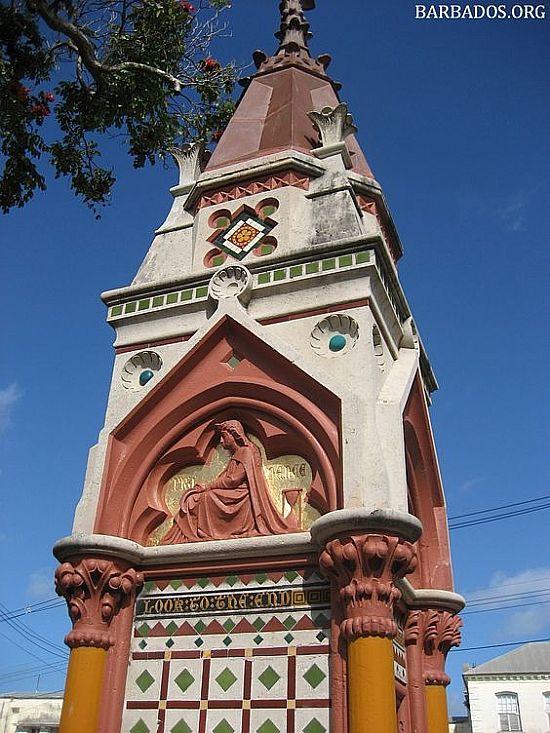
The upper part of the Montefiore drinking fountain in Bridgetown. Photo from Barbados Pocket Guide
John Costello Montefiore married Mary Elizabeth Law. A beautiful silk wedding waistcoat in the Victoria and Albert Museum was worn not by him but by one of his sons who carried his father's name, John, at his wedding in 1845.
Another of the eight children of John Costello and Mary Elizabeth was Thomas Law Montefiore who became a Church of England clergyman.
The Reverend T. L. Montefiore married Catherine Brice in Westbury on Severn in 1853 and this couple produced thirteen children amongst whom was Margaret Munro Montefiore.
Margaret was born in the rectory of the village of Charmouth Dorset in 1867.
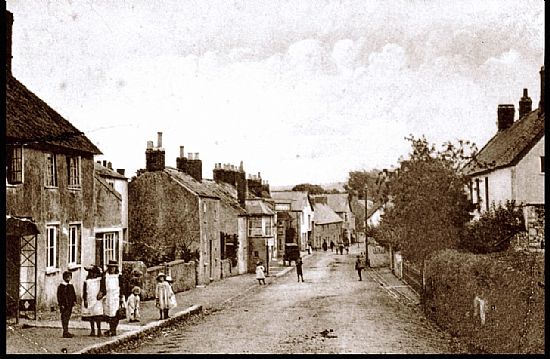
Photo of Charmouth Village courtesy of The Pavey Group
This "daughter of the Rectory" married "a son of the Manse" not in Dorset, however, but in Taiping.
Her father had died in 1890 but her mother lived on until 1899.
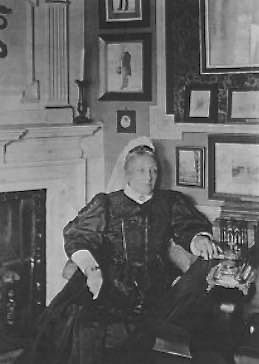
Catherine Brice, Mrs Thomas Montefiore, in old age
courtesy of The Pavey Group
Was Margaret one of those women sent East to find a husband?She was already 27 at the time of her marriage. This family is likely to reward further study. Margaret's nearest brother, for example, is said to have run away from home to work in the theatre and at one stage was the manager of the Seagate Theatre in Dundee.
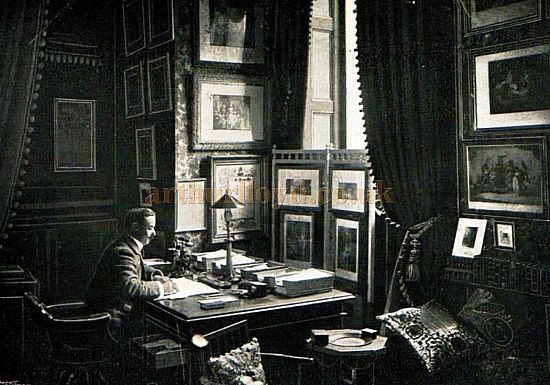
Margaret's brother Eade Montefiore in the manager's office in the Dundee theatre.
At least four children are thought to have been born to Alexander and Margaret Mackie. Two sons are claimed in one of the genealogy websites and two married daughters are mentioned in Grant Mackie’s obituary notice.
There is no doubt that married life increased rather than diminished Mackie’s active social life.
A journalist friend, J. H. M. Robson, wrote that the Mackies' hospitality was always generous. Mackie also, Robson admits, became noted for his ability to mix his drinks without getting drunk and was a “daredevil’ who particularly loved fast cars, many of which were imported from America.
His friendship with Foo Choo Choon was to result in Mackie’s greatest success as an engineer. This was an important contact for Alexander. Foo Choo Choon was probably the richest self-made man in the country at the time. he is said to have emlpoyed 10,000 coolies. A small Chinese temple remains as a reminder of his concern for their welfare.

A great many other institutions, however, owe their existence to this man's generosity. He was sometimes nicknamed the Chinese Carnegie.
The Sungei Besi mine near Kuala Lumpur had been entrusted to Mackie as General manager by this successful Chinese entrepreneur. It was the deepest open mine in the country but it was subject to flooding which threatened its very existence let alone its productivity.
Mackie installed the largest possible electric pump run by a 19 kw dynamo which also lit the mine lamps. The Ipoh Echo noted that the pump was able to “cope with all the water in the mine, including Mr Mackie’s famous aerated water”. Was this a reference to another of Grant Mackie’s ingenious sidelines or just more dredger fountains?
We catch glimpses of Mackie in the newspaper reports of various meetings of leaders of the mining industry and he seems to have been more and more respected across the whole community as time went by.
He decided, however, to retire to Port Said. It is possible that he felt it would allow Margaret to be nearer some of her Jewish relatives but most all this was a place where all the world called or at least might be seen steaming by every day. Port Said was also yet another very cosmopolitan place.
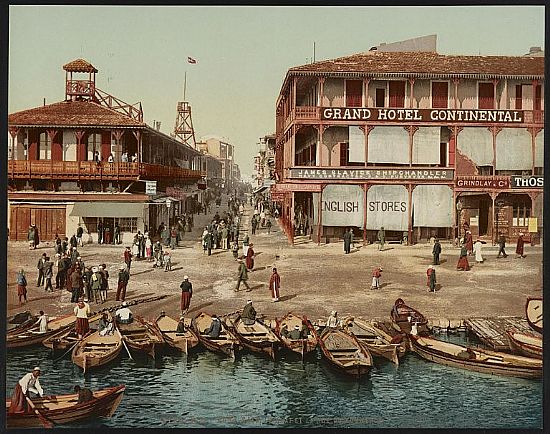
Rue de Commerce, Port Said ca 1890-1910: Library of Commerce.
Most of all, though, for an engineer it meant living daily alongside one of the great engineering wonders of the world, the Suez Canal.
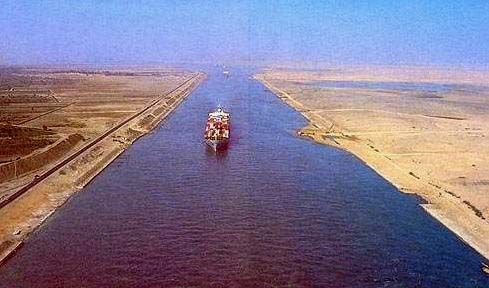
Even after retirement he continued to visit Malayasia occasionally. He seems to have felt it was his home but he presumably also had business interests still to attend to. There are no records of visits to Scotland at present nor have any letters been preserved which allow us to know if he retained contact with his family.
It was in Port Said that Mackie died in November 1933 after a short retirement.
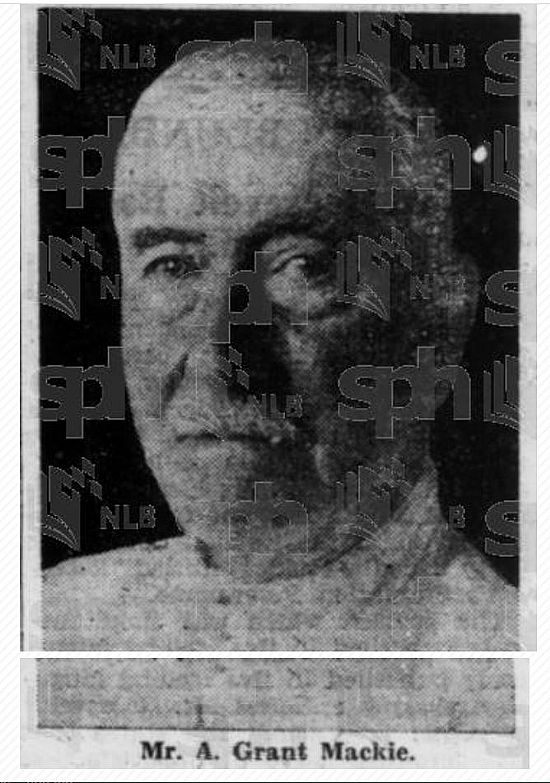 Photo that appeared in The Straits Times of A.G. Mackie along with his obituary
Photo that appeared in The Straits Times of A.G. Mackie along with his obituary
Margaret lived on to the grand old age of 96. She died in Glasgow on 2nd March 1963.
If the genealogical information on line is correct she may have moved there to be with one of their sons, William Robert Mackie, who was a Glasgow architect and town planner.
A personal note from Dr Ho September 2020:
The Malays called Mackie's dredge Lombong Hantu probably because they were in awe of it having never seen a structure like that before. By the way, Mackie was a visionary. He was proven right because ultimately the dredge proved to be the saviour of the country's tin industry. Personally he made his fortune at Petaling with his dredge and was able to retire. But he could have made his fortune 20 years earlier at Tronoh. He was given the prospecting rights at Tronoh before Foo Choo Choon but somehow he thought there was no tin in it. Tronoh Mines was the richest mine in the country for many years and was the first public-listed tin company in the UK.. Mackie had his share of ups and downs.
This mini-biography acknowledges gratefully the help of
Dr Ho Tak Ming, Maria Dass, and Margaret Dougherty.
Written Sources for this mini biography include
Ho Tak Ming: Ipoh: When Tin Was King, Perak Academy
Ho Tak Ming : Generations, Perak Academy
Both these books are available in part on Google Books but both are difficult to obtain and prohibitively expensive in printed form in the UK. There are no ebooks available.
J.H.M. Robson: Records and Recollections (1889-1934), Kyle, Palmer and Co Ltd 1934 available complete on line
Sultan Nazrin Shah: “Early 20th Century Tin Mining Development” Economic History of Malaya.University of Malaya.

